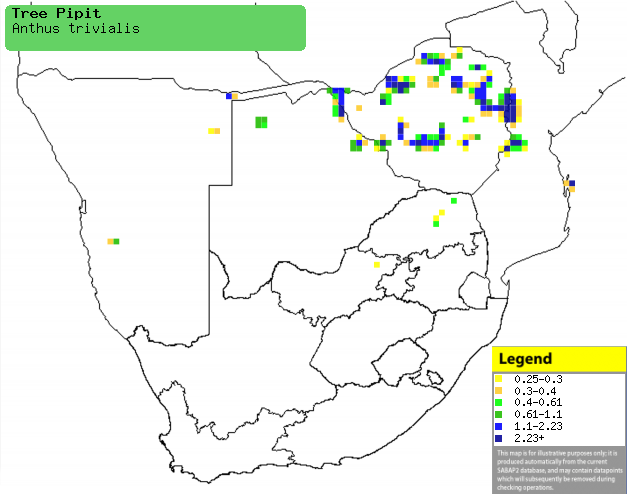|
Anthus trivialis (Tree pipit)
Boomkoester [Afrikaans]; Boompieper [Dutch]; Pipit ŕ gorge
rousse [French]; Baumpieper [German]; Petinha-das-árvores [Portuguese]
Life
> Eukaryotes >
Opisthokonta
> Metazoa (animals) >
Bilateria >
Deuterostomia > Chordata >
Craniata > Vertebrata (vertebrates) > Gnathostomata (jawed
vertebrates) > Teleostomi (teleost fish) > Osteichthyes (bony fish) > Class:
Sarcopterygii (lobe-finned
fish) > Stegocephalia (terrestrial
vertebrates) > Tetrapoda
(four-legged vertebrates) > Reptiliomorpha > Amniota >
Reptilia (reptiles) >
Romeriida > Diapsida > Archosauromorpha > Archosauria >
Dinosauria
(dinosaurs) > Saurischia > Theropoda (bipedal predatory dinosaurs) >
Coelurosauria > Maniraptora > Aves
(birds) > Order: Passeriformes
> Family: Motacillidae > Genus: Anthus
Distribution and habitat
Breeds from western Europe and Scandinavia to central Asia,
heading south in the non-breeding season to India and sub-Saharan Africa from
southern Mauritania to Somalia south through Uganda, Tanzania, Zambia, southern
DRC and Angola to southern Africa. Here it is fairly common in Zimbabwe,
marginally extending into central Mozambique, north-eastern Botswana and
isolated patches of north-eastern South Africa and Namibia. It generally prefers
grassland with scattered large trees, but it also occurs in broad-leaved
woodland, grassy hillsides, edges of woodland, exotic plantations and gardens.
|
 |
|
Distribution of Tree pipit in southern Africa,
based on statistical smoothing of the records from first SA Bird Atlas
Project (©
Animal Demography unit, University of
Cape Town; smoothing by Birgit Erni and Francesca Little). Colours range
from dark blue (most common) through to yellow (least common). |
Movements and migrations
Non-breeding visitor to southern Africa, mainly
arriving in the period from mid October to mid November and leaving
in late March and early April.
Food
It mainly eats insects and other invertebrates,
supplemented with fruit, seeds and buds, doing most of its foraging on the
ground. The following food items have been recorded
in its diet:
- Invertebrates
- Plants
- fruit
- seeds
- buds
- new leaves
Threats
Not threatened.
References
-
Hockey PAR, Dean WRJ and Ryan PG 2005. Roberts
- Birds of southern Africa, VIIth ed. The Trustees of the John Voelcker
Bird Book Fund, Cape Town.
|
